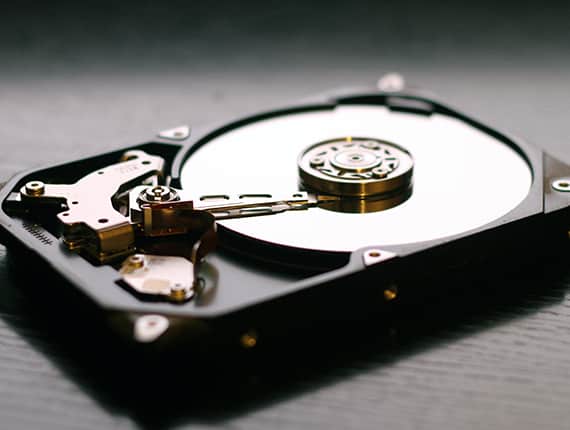October 4, 2024
Debunking Myths About Hard Drive Shredding and Data Recovery: What You Need to Know
In our exploration of these myths, we will unravel what really happens when you delete files and bust the myths that can lead to misunderstandings about data recovery.
Many of us have heard advice about putting hard drives in the freezer or simply smashing them with a hammer, but do these methods really work? The truth is, achieving secure data erasure requires more than just these DIY methods.
Key Takeaways
- Data recovery is possible even after files are deleted.
- Many common DIY methods do not securely erase data.
- Understanding proper data destruction ensures information security.
Misconceptions About Physical Damage Recovery
A common misconception is that once a hard drive incurs physical damage, data cannot be recovered. While it's true that physical damage complicates recovery, it doesn't always mean data is lost forever. Data recovery specialists can handle physically damaged drives using sophisticated techniques.
For instance, professionals might open the drive in a clean room to reconstruct damaged components, leading to potentially retrieving the information. Misunderstandings like these often arise from myths about DIY methods being sufficient as a means of destruction. However, with most manual methods of hard drive destruction, the data can be recovered.
The Truth Behind Hard Drive Shredding and Deletion
We need to separate facts from misconceptions about hard drive shredding and data deletion. This ensures our methods for safeguarding data are effective. Understanding the difference between formatting, deleting files, and physically destroying drives is crucial in protecting our confidential information.
Formatting vs. Deletion
When we format a hard drive, we're not actually erasing the data. Formatting removes the file system information, making the space appear available for new data. Until overwritten, the original data can still be recovered. This is why formatting alone isn’t enough if we aim to securely delete sensitive information.
Deleting files also doesn’t permanently remove data. Instead, it marks the storage space as available, leaving the actual data intact until it’s overwritten.
Specialized software can often retrieve this information, posing a risk to data security if sensitive data isn't properly handled. It’s essential for us to understand that neither formatting nor simple file deletion guarantees data is irretrievable.
Hard Drive Destruction Myths
There are many myths about how to destroy hard drives effectively. For instance, some believe that dunking a hard drive in water or hitting it with a hammer will reliably destroy data. These methods are unreliable because they often do not compromise all parts of the drive.
Many misconceptions surround the idea of destroying or recovering data from hard drives. These myths, such as using the freezer trick or magnets, are often misguided and can lead to improper practices. Most magnets are not strong enough to delete the data.
Hard drives are designed to protect the data they hold, even against such attempts.
Physical Destruction for Data Security
For ultimate data security, physical destruction of hard drives is vital. Hard drive shredding, or using degaussing equipment renders the drive unusable and the data unrecoverable. Thus, a more secure approach is using professional hard drive destruction shredding services that ensure complete and safe destruction.
This method ensures that confidential information is completely destroyed and cannot be accessed by unauthorized individuals.
One must consider a secure chain of custody when dealing with physical destruction. This involves strict control over who handles the drives before and during the destruction process.
Adhering to these procedures minimizes the risk of data breaches and maintains compliance with regulations. Incorporating physical destruction as part of our data security strategy can significantly enhance protection.
Protecting Sensitive Information
Protecting our sensitive information, like personally identifiable information or company emails, demands strict security measures.
Using strong passwords and multi-factor authentication can deter unauthorized access. Regularly updating our software helps protect against vulnerabilities.
Sensitive corporate data should be encrypted both in storage and during transmission. We should also classify, and tag data based on its sensitivity, ensuring that more critical data receives additional protections.
Training our staff on recognizing phishing schemes and other cyber threats further safeguards sensitive information. Awareness is essential for preventing accidental breaches.
Employees need to know the protocols for handling and reporting any security incidents they encounter.
When it comes to hard drives; always think about the ramification of data getting into the wrong hands. Ask yourself. Is not using a professional shredding service really worth the risk?
Frequently Asked Questions
Understanding the details of hard drive shredding and possible data recovery can help us ensure our information is properly protected. We address common questions to clarify the differences between physical and software-based methods, environmental considerations, and verification of data destruction.
Once a hard drive is shredded, data recovery is not feasible. Shredding involves cutting the drive into small pieces, which makes any form of data retrieval virtually impossible. Industrial shredders slice the drive into tiny, irregular pieces to ensure data cannot be reconstructed.
Shredding a hard drive physically destroys it, ensuring all data is unrecoverable. On the other hand, formatting only erases file system information. While formatting removes the data structure, the information itself remains intact until it's overwritten. Therefore, it is not a secure method for data removal.
Software-based methods overwrite existing data to prevent recovery. While these can be quite effective, they often require multiple passes and still leave a slight chance that data fragments could be retrieved. Physical shredding offers a more definitive solution as it destroys the physical hardware.
To ensure data has been securely destroyed, we can request a certificate of destruction from the shredding service provider. This certificate typically includes details about the process and confirms that the hard drives were destroyed according to industry standards.
This provides peace of mind and a record for compliance purposes.

